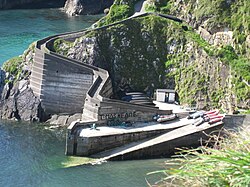Dunquin
| Dunquin Irish: Dún Chaoin | |
| County Kerry | |
|---|---|
 Dún Chaoin pier | |
| Location | |
| Grid reference: | Q320008 |
| Location: | 52°8’1"N, 10°27’16"W |
| Data | |
| Local Government | |
Dunquin is a village in the Gaeltacht of western County Kerry, standing at the far western tip of the Dingle Peninsula, overlooking the Blasket Islands. At 10°27'16"W, it is the most westerly settlement of Ireland. Nearby Dunmore Head is the most westerly point of mainland Ireland.
The name of the village is from the Irish Dún Chaoin, meaning "Caon's stronghold". Because of its Gaelic-speaking status, the Galeic name has been declaued the only official name.
There is dramatic cliff scenery, with a view of the Blasket Islands, where Peig Sayers lived. A museum in the village tells the story of the Blaskets and the lives of the people who lived there including the well-known writers of the island, which includes Sayers, Tomás Ó Criomhthain, and Muiris Ó Súilleabháin. In 1588, as the Spanish Armada fled homeward by way of Ireland, many of King Philip's ships sought shelter in the Blasket Sound (the area between Dún Chaoin and the Islands) and some were wrecked there. A memorial stands on the cliffs overlooking the site.
Scenes from the 1970 film Ryan's Daughter were shot at Coumineole Beach and Ceathrú (Caharhoo) in Dún Chaoin. The town's then-struggling economy was largely revived by the production of the film.
People
Dunquin is famous as the place of birth of the Irish language author and seanchaí, Peig Sayers (1873 - 1958).